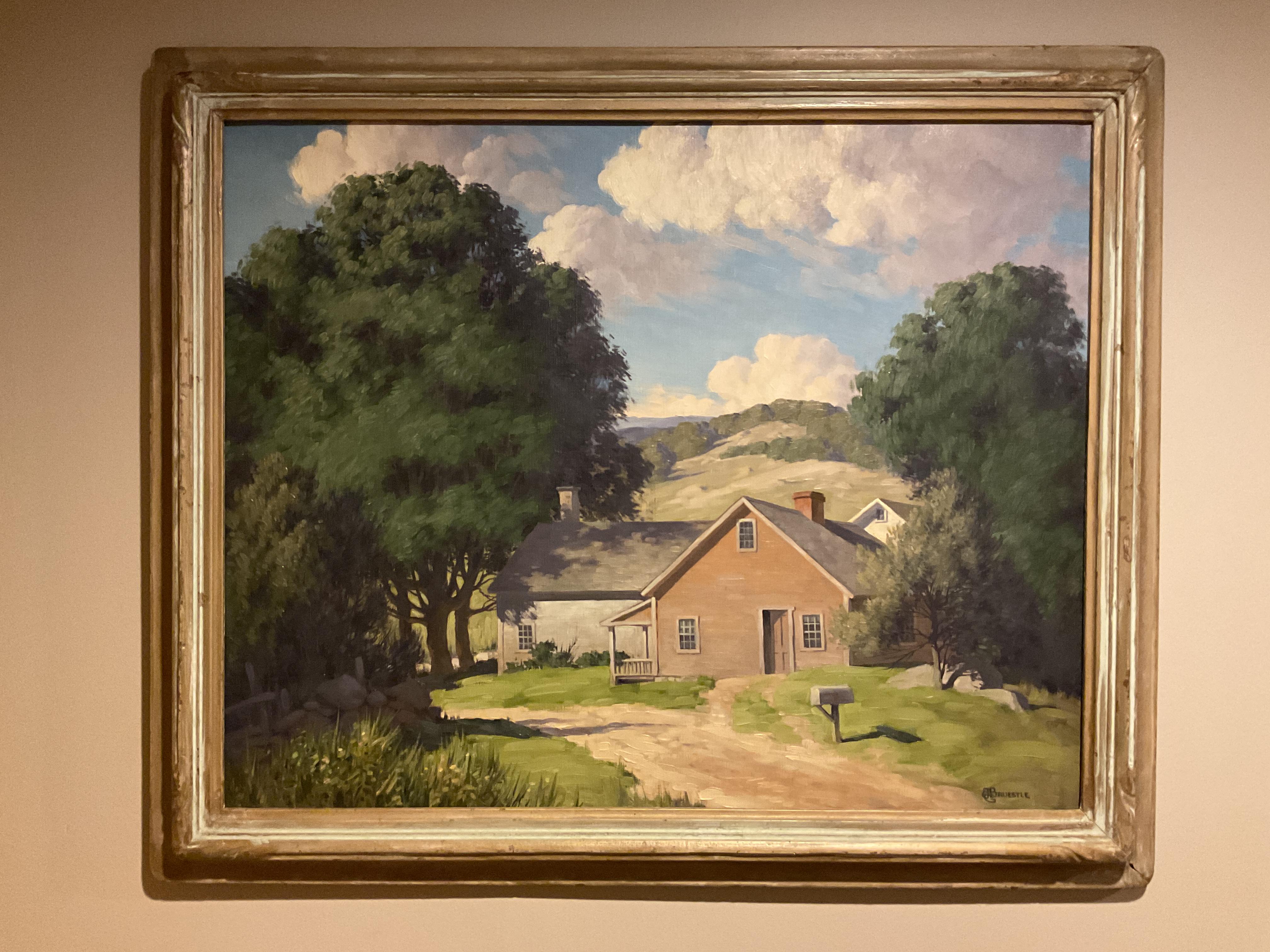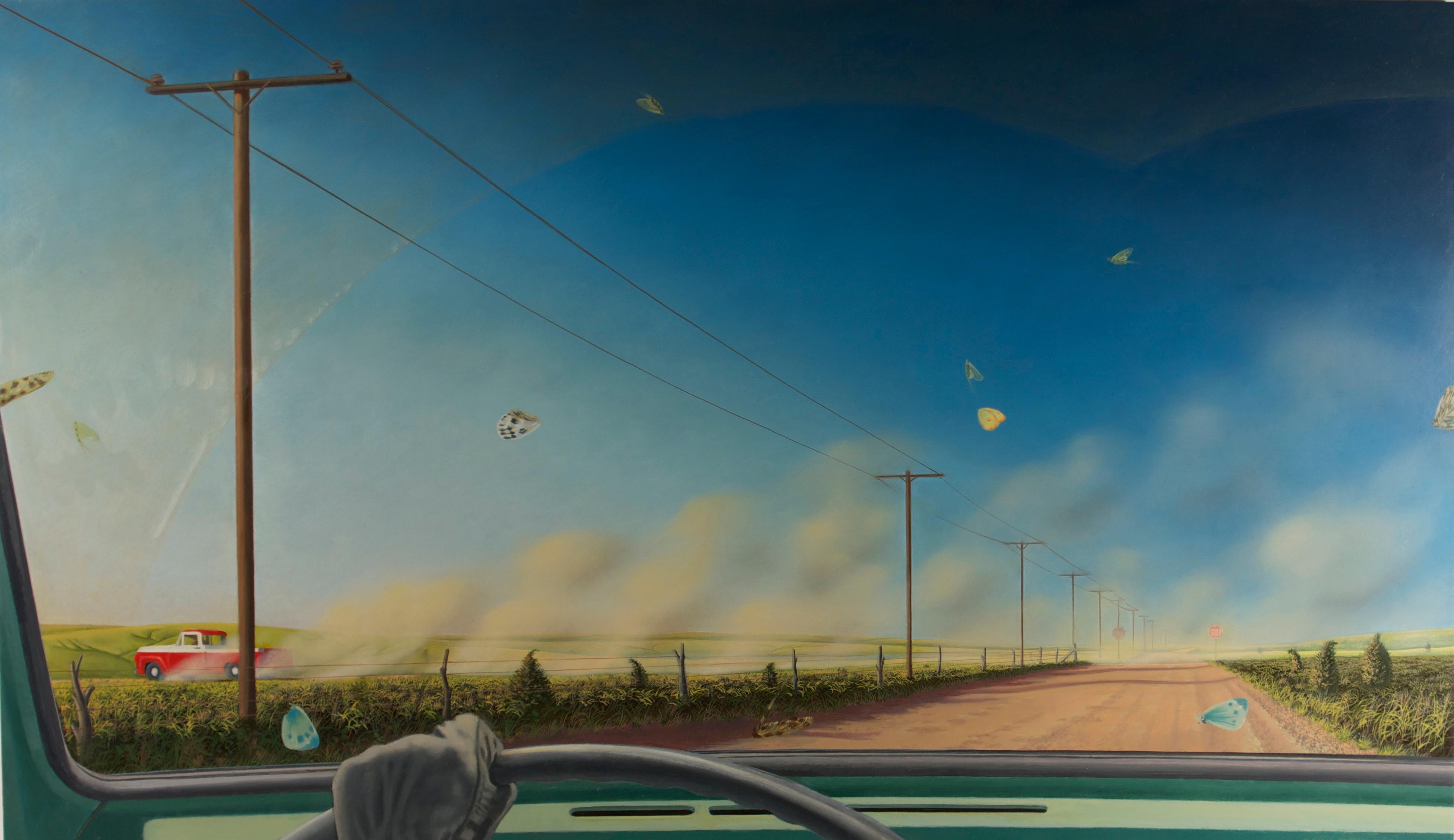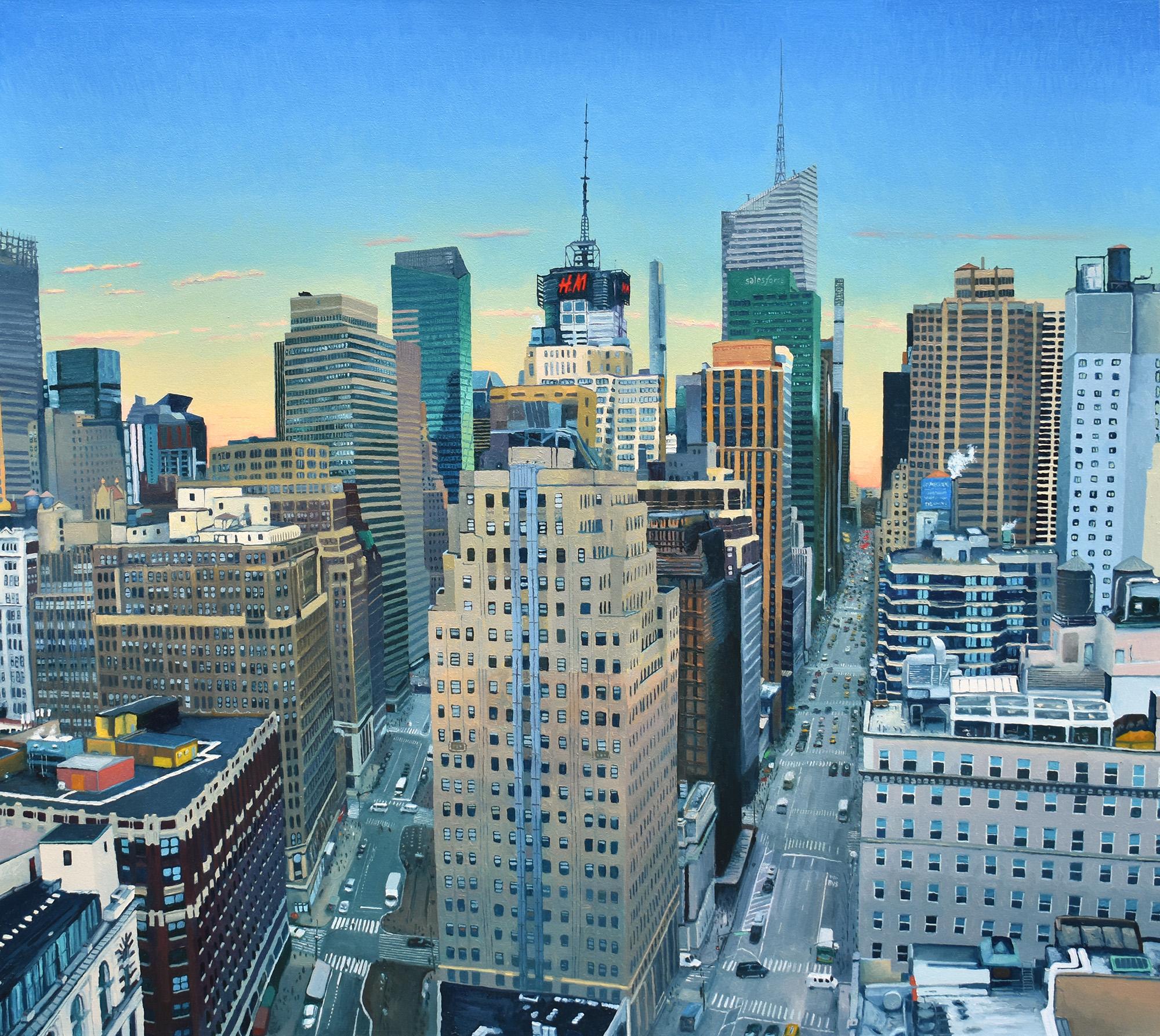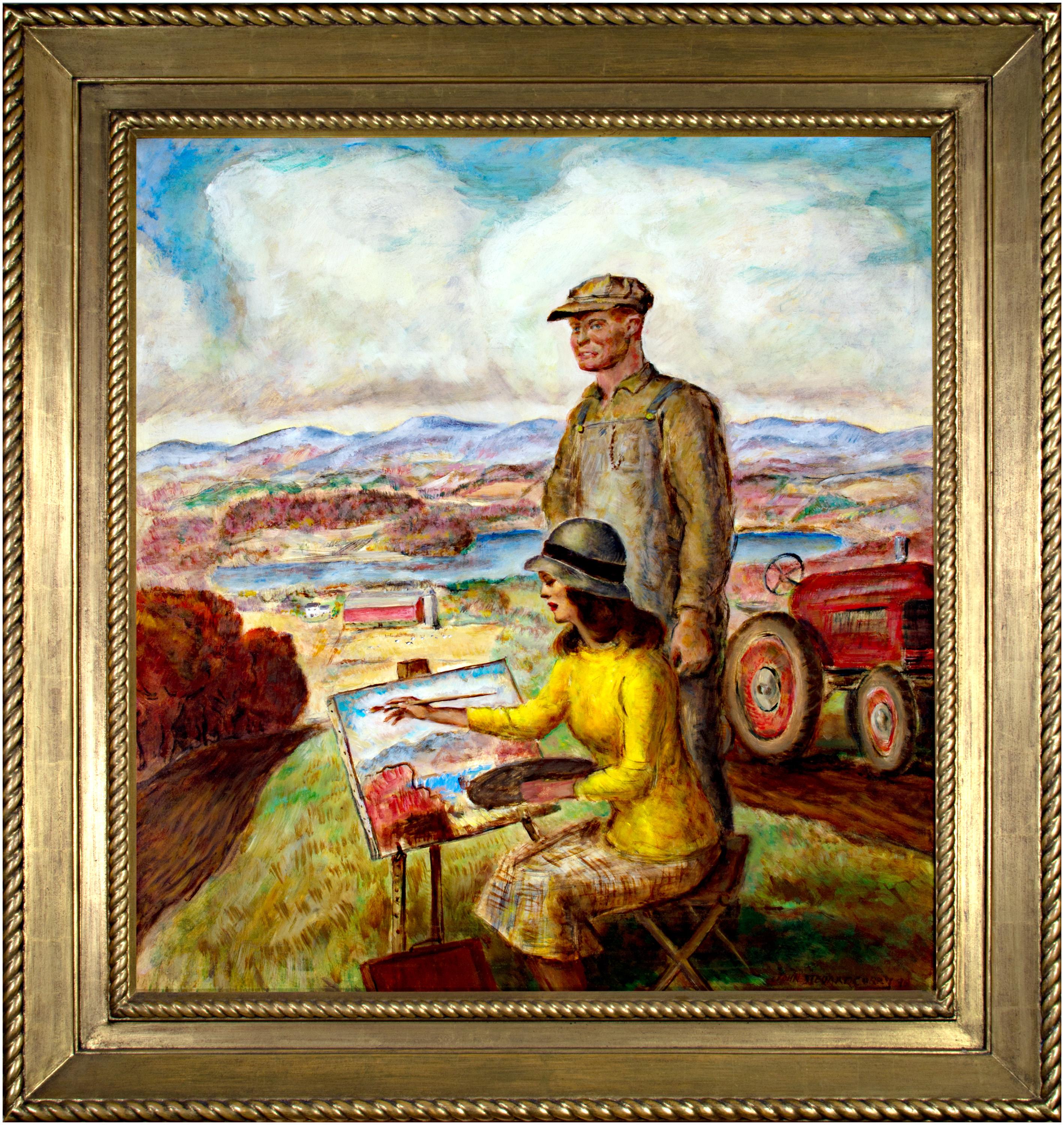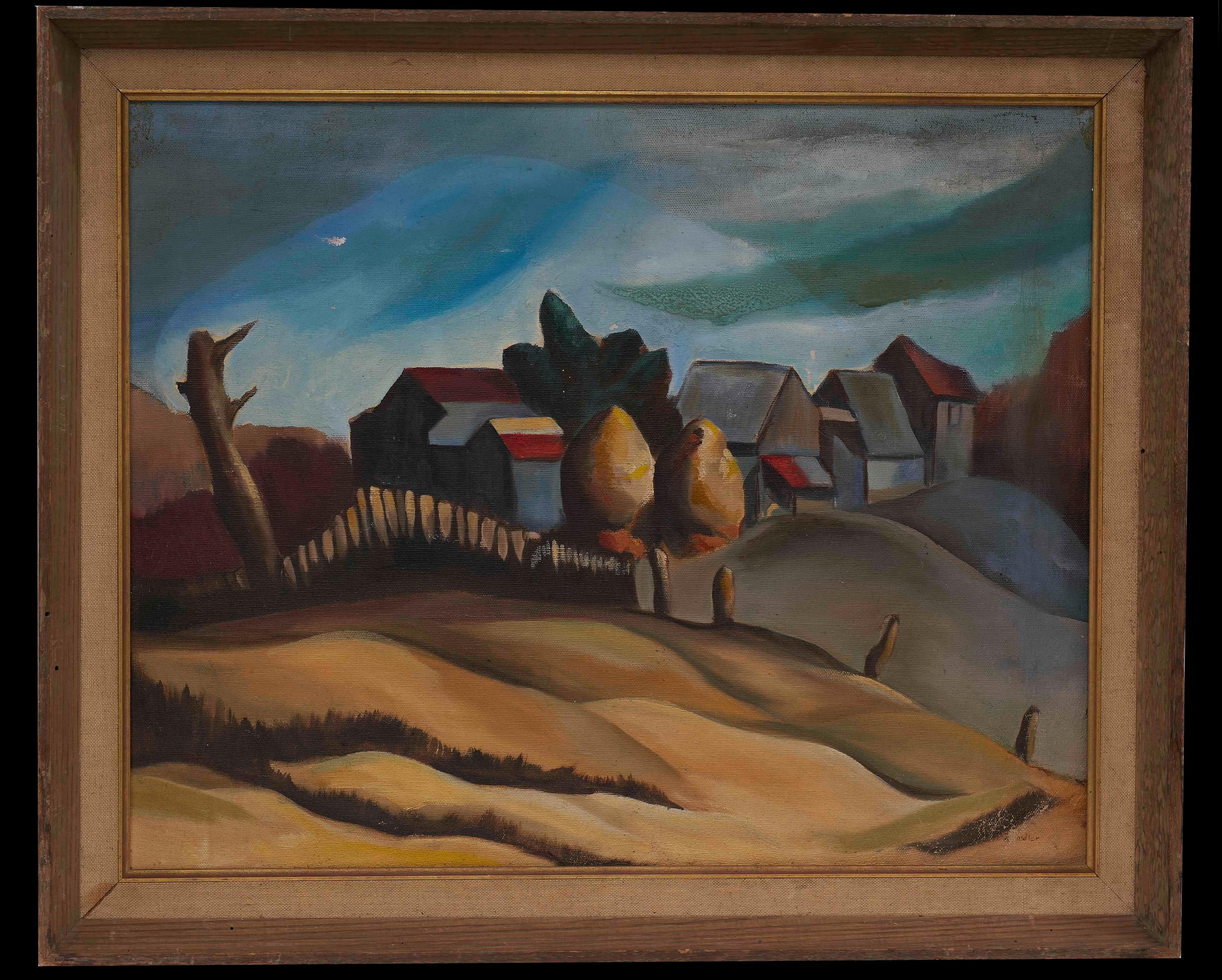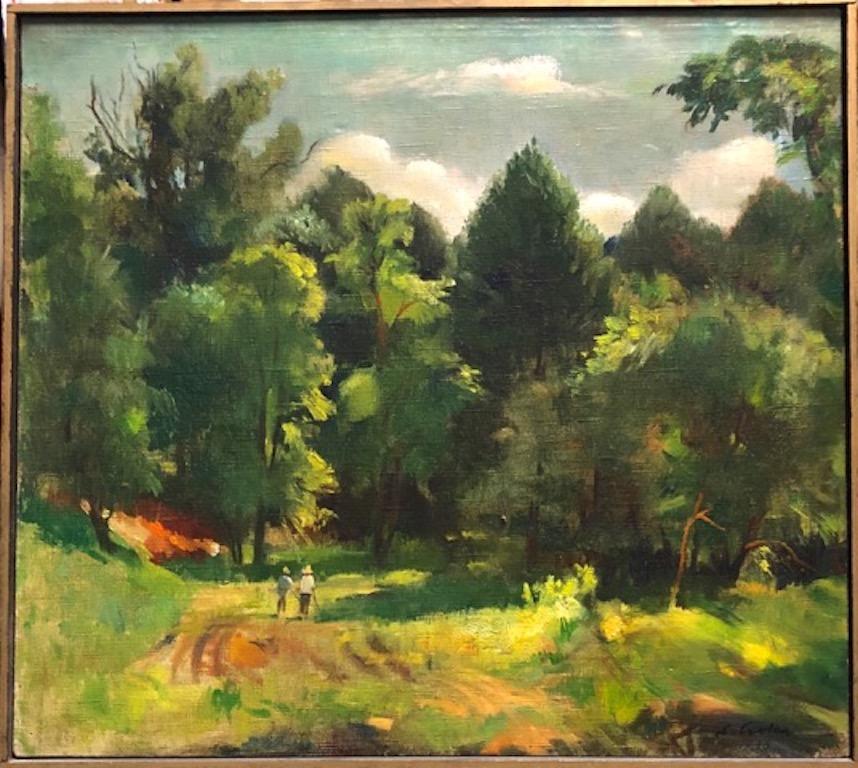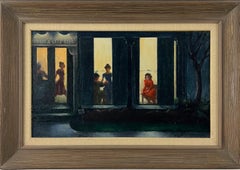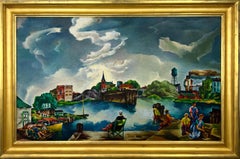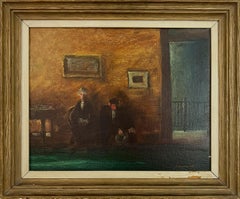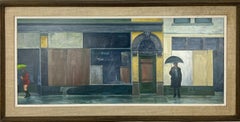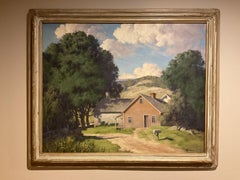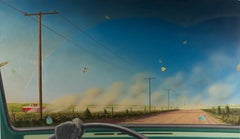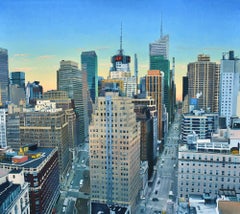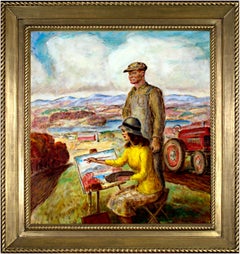Items Similar to Coffee Time-American Scene Painting-Cranbrook Academy of Art-Michigan Travel
Want more images or videos?
Request additional images or videos from the seller
1 of 8
Zoltan SepeshyCoffee Time-American Scene Painting-Cranbrook Academy of Art-Michigan Travel
$16,000
£12,038.51
€13,908.30
CA$22,612.18
A$24,552.43
CHF 13,002.31
MX$300,942.43
NOK 160,908.67
SEK 152,050.18
DKK 103,805.81
About the Item
This is a delightful, large oil painting of a coffee run to a quintessential diner. Zolton Sepeshy, who lived and painted in Michigan, captured the stillness of the late-night or early morning excursion. The perspective of this work allows the viewer to feel like they are climbing the dunes and could get sand in their shoes.
Painting is presented in an original artist frame.
Framed Dimensions: 36 x 30 Inches
Image Dimensions: 29.5 x 23.5 Inches
The frame is wired for hanging.
Signed lower left. Back has a partial label from Midtown Gallery and an image title.
Born in Kassa, Hungary, Zoltan Sepeshy later became a resident artist of Birmingham, Michigan. He studied at the Royal Academy of Art in Budapest as well as in Vienna and Paris. He was appointed as an art instructor at the Detroit Society of Arts and Crafts and later at the Cranbrook Academy of Arts in Bloomfield Hills, Michigan.
His first solo exhibition took place in New York, at Newhouse Galleries, in 1932. Sepeshy showed 20 paintings and eight graphics, including depictions of urban America, genre, and European subjects, all done in a modernist manner seemingly derived from Cézanne and the Cubists.
He was a major painter of the American Scene and depicted the small towns and harbors around Lake Michigan. A further gauge of his importance is that during his lifetime, museums ranging from national institutions such as the Art Institute of Chicago to university galleries such as the Sheldon Art Museum at the University of Nebraska acquired his work for their permanent collections.
- Creator:Zoltan Sepeshy (1898 - 1974)
- Dimensions:Height: 30 in (76.2 cm)Width: 36 in (91.44 cm)Depth: 2 in (5.08 cm)
- Medium:
- Movement & Style:
- Period:
- Condition:Image condition is consistent with the age of the piece. No visible damage or paint loss.
- Gallery Location:Marco Island, FL
- Reference Number:Seller: INV4231stDibs: LU2866216478322
About the Seller
New to 1stDibs
Joined in the past six months.
No Reviews Yet
Vetted Professional Seller
Every seller passes strict standards for authenticity and reliability
1stDibs seller since 2025
- ShippingRetrieving quote...Shipping from: Marco Island, FL
- Return Policy
Authenticity Guarantee
In the unlikely event there’s an issue with an item’s authenticity, contact us within 1 year for a full refund. DetailsMoney-Back Guarantee
If your item is not as described, is damaged in transit, or does not arrive, contact us within 7 days for a full refund. Details24-Hour Cancellation
You have a 24-hour grace period in which to reconsider your purchase, with no questions asked.Vetted Professional Sellers
Our world-class sellers must adhere to strict standards for service and quality, maintaining the integrity of our listings.Price-Match Guarantee
If you find that a seller listed the same item for a lower price elsewhere, we’ll match it.Trusted Global Delivery
Our best-in-class carrier network provides specialized shipping options worldwide, including custom delivery.More From This Seller
View AllWomen's City Club, Youngstown, Ohio. American Historical Scene Painting.
Located in Marco Island, FL
An accomplished American Scene painter, Clyde Singer successfully captured everyday life during his long career. A unique aspect of American life is depicted in this painting, entitl...
Category
1940s American Realist Landscape Paintings
Materials
Oil, Board
Summer Resort in Michigan -Modernist Mid-Century Saugatuck Oil Painting
Located in Marco Island, FL
Summer Resort in Michigan is an exceptional work painted by the Chicago Modernist, William Schwartz. He studied at the Art Institute of Chicago shortly ...
Category
1940s American Modern Landscape Paintings
Materials
Canvas, Oil
Doctor's Office. Mid-Century American Scene Oil Painting Youngstown, OH.
Located in Marco Island, FL
An anxious moment waiting to see the doctor is depicted by Clyde Singer in this quiet and still painting. Entitled Doctor's Office (1949), Singer paints a moment of anticipation and...
Category
1940s American Realist Interior Paintings
Materials
Oil, Panel
Patched Front. Original Urban American Street Scene Painting.
Located in Marco Island, FL
American city scene of a man on the sidewalk with an umbrella in front of storefronts with a geometric facade. American life is captured in this Clyde Singer painting, Patched Fron...
Category
1970s American Realist Landscape Paintings
Materials
Canvas, Oil
After The Shower-Mid-Century Street Scene Oil Painting. Realist Urban America.
Located in Marco Island, FL
American life is captured in this Clyde Singer painting, After the Shower (1949), where he depicts a woman walking down the street after a storm with her umbrella in hand. An accompl...
Category
1940s American Realist Landscape Paintings
Materials
Oil, Board
Twosome - Meeting for Coffee Original Oil Painting. 20th Century Coffee Date.
Located in Marco Island, FL
American life is captured in this Clyde Singer painting, Twosome (1991), where he depicts a couple meeting for coffee. An accomplished American Scene painter, Singer successfully cap...
Category
Late 20th Century American Realist Figurative Paintings
Materials
Oil, Board
You May Also Like
Vintage American Regional Landscape Painting by Bertram Bruestle, Connecticut
Located in Baltimore, MD
Born in New York City in 1906, Bertram George was the son of beloved Lyme, Connecticut artist George Bruestle. The younger Bruestle’s earliest works w...
Category
Mid-20th Century Post-Impressionist Landscape Paintings
Materials
Oil
Dust, surrealist pastoral oil painting
Located in New York, NY
Both spare and dynamic, Karl Hartman’s hyper-saturated countrysides and surreal depictions of Americana perfectly match the vividness of our late-summer h...
Category
2010s American Realist Landscape Paintings
Materials
Oil, Panel
Morning Coffee
By David Leonard
Located in Fairfield, CT
The primary subjects of my paintings are 21st century man's working monuments, which represent our culture's dedication to production and consumption. The essence of our way of life ...
Category
21st Century and Contemporary American Realist Landscape Paintings
Materials
Canvas, Oil
$5,200 Sale Price
20% Off
'Sketching Wisconsin' original oil painting, Signed
By John Steuart Curry
Located in Milwaukee, WI
John Steuart Curry
"Sketching Wisconsin," 1946
oil on canvas
31.13 x 28 inches, canvas
39.75 x 36.75 x 2.5 inches, frame
Signed and dated lower right
Overall excellent condition
Presented in a 24-karat gold leaf hand-carved wood frame
John Steuart Curry (1897-1946) was an American regionalist painter active during the Great Depression and into World War II. He was born in Kansas on his family’s farm but went on to study art in Chicago, Paris and New York as young man. In Paris, he was exposed to the work of masters such as Peter Paul Rubens, Eugène Delacroix and Jacques-Louis David. As he matured, his work showed the influence of these masters, especially in his compositional decisions. Like the two other Midwestern regionalist artists that are most often grouped with him, Grant Wood (American, 1891-1942) and Thomas Hart Benton (American, 1889-1975), Curry was interested in representational works containing distinctly American subject matter. This was contrary to the popular art at the time, which was moving closer and closer to abstraction and individual expression.
Sketching Wisconsin is an oil painting completed in 1946, the last year of John Steuart Curry’s life, during which time he was the artist-in-residence at the University of Wisconsin in Madison. The painting is significant in Curry’s body of work both as a very revealing self-portrait, and as a landscape that clearly and sensitively depicts the scenery of southern Wisconsin near Madison. It is also a portrait of the artist’s second wife, Kathleen Gould Curry, and is unique in that it contains a ‘picture within a picture,’ a compositional element that many early painting masters used to draw the eye of the viewer. This particular artwork adds a new twist to this theme: Curry’s wife is creating essentially the same painting the viewer is looking at when viewing Sketching Wisconsin.
The triangular composition of the figures in the foreground immediately brings focus to a younger Curry, whose head penetrates the horizon line and whose gaze looks out towards the viewer. The eye then moves down to Mrs. Curry, who, seated on a folding stool and with her hand raised to paint the canvas on the easel before her, anchors the triangular composition. The shape is repeated in the legs of the stool and the easel. Behind the two figures, stripes of furrowed fields fall away gently down the hillside to a farmstead and small lake below. Beyond the lake, patches of field and forest rise and fall into the distance, and eventually give way to blue hills.
Here, Curry has subverted the traditional artist’s self-portrait by portraying himself as a farmer first and an artist second. He rejects what he sees as an elitist art world of the East Coast and Europe. In this self-portrait he depicts himself without any pretense or the instruments of his profession and with a red tractor standing in the field behind him as if he was taking a break from the field work. Here, Curry’s wife symbolizes John Steuart Curry’s identity as an artist. Compared with a self-portrait of the artist completed a decade earlier, this work shows a marked departure from how the artist previously presented and viewed himself. In the earlier portrait, Curry depicted himself in the studio with brushes in hand, and with some of his more recognizable and successful canvases behind him. But in Sketching Wisconsin, Curry has taken himself out of the studio and into the field, indicating a shift in the artist’s self-conception.
Sketching Wisconsin’s rural subject also expresses Curry’s populist ideals, that art could be relevant to anyone. This followed the broad educational objectives of UW’s artist-in-residence program. Curry was appointed to his position at the University of Wisconsin in 1937 and was the first person to hold any such position in the country, the purpose of which was to serve as an educational resource to the people of the state. He embraced his role at the University with zeal and not only opened the doors of his campus studio in the School of Agriculture to the community, but also spent a great deal of time traveling around the state of Wisconsin to visit rural artists who could benefit from his expertise. It was during his ten years in the program that Curry was able to put into practice his belief that art should be meaningful to the rural populace. However, during this time he also struggled with public criticism, as the dominant forces of the art market were moving away from representation. Perhaps it was Curry’s desire for public acceptance during the latter part of his career that caused him to portray himself as an Everyman in Sketching Wisconsin.
Beyond its importance as a portrait of the artist, Sketching Wisconsin is also a detailed and sensitive landscape that shows us Curry’s deep personal connection to his environment. The landscape here can be compared to Wisconsin Landscape of 1938-39 (the Metropolitan Museum of Art), which presents a similar tableau of rolling hills with a patchwork of fields. Like Wisconsin Landscape, this is an incredibly detailed and expressive depiction of a place close to the artist’s heart. This expressive landscape is certainly the result of many hours spent sketching people, animals, weather conditions and topography of Wisconsin as Curry traveled around the state. The backdrop of undulating hills and the sweeping horizon, and the emotions evoked by it, are emphatically recognizable as the ‘driftless’ area of south-central Wisconsin. But while the Metropolitan’s Wisconsin Landscape conveys a sense of uncertainty or foreboding with its dramatic spring cloudscape and alternating bands of light and dark, Sketching Wisconsin has a warm and reflective mood. The colors of the foliage indicate that it is late summer and Curry seems to look out at the viewer approvingly, as if satisfied with the fertile ground surrounding him.
The landscape in Sketching Wisconsin is also revealing of what became one of Curry’s passions while artist-in-residence at UW’s School of Agriculture – soil conservation. When Curry was a child in Kansas, he saw his father almost lose his farm and its soil to the erosion of The Dust Bowl. Therefore, he was very enthusiastic about ideas from UW’s School of Agriculture on soil conservation methods being used on Wisconsin farms. In Sketching Wisconsin, we see evidence of crop rotation methods in the terraced stripes of fields leading down the hillside away from the Curry’s and in how they alternate between cultivated and fallow fields.
Overall, Sketching Wisconsin has a warm, reflective, and comfortably pastoral atmosphere, and the perceived shift in Curry’s self-image that is evident in the portrait is a positive one. After his rise to favor in the art world in the 1930’s, and then rejection from it due to the strong beliefs presented in his art, Curry is satisfied and proud to be farmer in this self-portrait. Curry suffered from high blood...
Category
1940s American Realist Figurative Paintings
Materials
Canvas, Oil
American Regionalist Landscape Painting by Very Talented Mystery Artist Signed
Located in San Francisco, CA
American Regionalist Landscape Painting by Very Talented Mystery Artist
Signed Lower Right
Early 20th century
In good vintage condition with areas of paint loss
Oil on Canvas
...
Category
20th Century Landscape Paintings
Materials
Canvas, Oil
Landscape American Hungarian European Modernism 1938 Realism Long Island WPA era
By Stephen Csoka
Located in New York, NY
Landscape American Hungarian European Modernism 1938 Realism Long Island WPA era. The canvas measures 18” x 20". The artist signed the stretcher as well as the canvas.
The scene depicts a spots in New York where Queens borders with Nassau county, Rosedale, which abuts the Five Towns. The border runs through Hook Creek, another painting we are currently offering.
Stephen (Istvan) Csoka was born in Gárdony, Hungary on January 2, 1897 and died in New York in 1989. He is best remembered as a painter and etcher of portraits, nudes, landscapes, genre, and horses. Csoka studied at the Budapest Royal Academy of Art and his memberships include Associate of the National Academy of Design in New York City; the Society of American Etchers in Brooklyn, NY; the Society of Brooklyn Artists; and the Hungarian Etchers Association.
Csoka's exhibitions and awards include a medal at the Barcelona International Exhibition in 1929; a prize at the City of Budapest Exhibit in 1930; prizes at the Society of American Etchers in 1942 and 1945; prizes at the Library of Congress in 1944 and 1946; a prize at the Society of Brooklyn Artists in 1944; a prize at the Philadelphia Watercolor Club in 1945; the Corcoran Gallery of Art in 1945; the Carnegie Institute in 1943, 1944, and 1945; the Art Institute of Chicago in 1944; the Los Angeles Museum of Art in 1945; the National Academy of Design from 1940 through 1945; one-artist shows at the Contemporary Artists in 1940, 1943, and 1945; and the Minneapolis State Fair in 1943. *Stephen continued to recieve awards and exhibit his work throughout his life. In 1997, Hofstra Museum sponsored a Retrospective/Centennial exhibition in honor of his birth.
Collections representing Csoka's work are the Metropolitan Museum of Art, New York, NY; the Brooklyn Museum, Brooklyn, NY; the Museum of Fine Arts, Boston, MA; the British Museum, London, England; the Bezalel National Museum, Jerusalem, Israel; the Butler Institute of American Art, Youngstown, Ohio; Whistler House Museum of Art, Lowell, MA; the Cleveland Museum of Art, Cleveland, OH; Columbus Museum of Art, Columbus, OH; the Sheldon Swope Art Museum, Terre Haute, IN; the Mobile Museum of Art, Mobile, AL; the Frederick R. Weisman Art Museum, Minneapolis, MN; the Museum of New Mexico, Santa Fe, NM; the Budapest Museum of Fine Arts, Budapest, Hungary; Hungarian National Gallery, Budapest, Hungary, the Museum of the City of Budapest, Budapest, Hungary; the Library of Congress, Washington, DC; Carnegie Museums of Pittsburgh, Pittsburgh, PA; the Chrysler Museum of Art, Norfolk, VA; Georgia Museum of Art, Athens, GA; Hofstra Museum, Hofstra University, Hempstead, NY; Holocaust Museum, Glen Cove, NY; National Academy of Art, New York, NY; New Orleans Museum of Art, New Orleans, LA; New York Historical Society, New York, NY;New York Public Library, New York, NY; National Gallery of Art, Washington, DC; Peabody Museum, Cambridge, MA; Pennsylvania Academy of the Fine Arts, Philadelphia, PA; Reading Public Museum, Reading, PA; Livingston Arts Center, Mount Morris, NY; Ball State Teachers College, Muncie, IN; City College, New York, NY; Fashion Institute of Technology, New York, NY; Hungarian Consulate, New York, NY; Hungarian Heritage, New Brunswick, NJ; Hunter College, New York, NY; IBM Collections; Princeton Print Club...
Category
1930s Realist Landscape Paintings
Materials
Canvas, Oil
More Ways To Browse
Vintage Cranbrook
Oil Paintings Michigan
Robert Wood Artist
San Diego Landscape
Scottish Sheep
Seth Winegar
Sheryl Roberts
Small Boat Paintings
Texas Bluebonnet Paintings
Thomas Hill
Vail Painting
Very Large Impressionist Painting
Windsor Oil Paintings
Australian Impressionist
Brittany Art Oil Boats
Cannes Oil
Carousel Oil Painting
Casper Vintage
